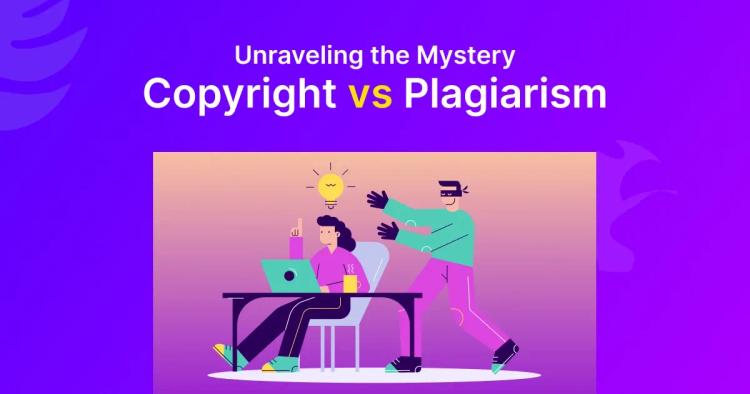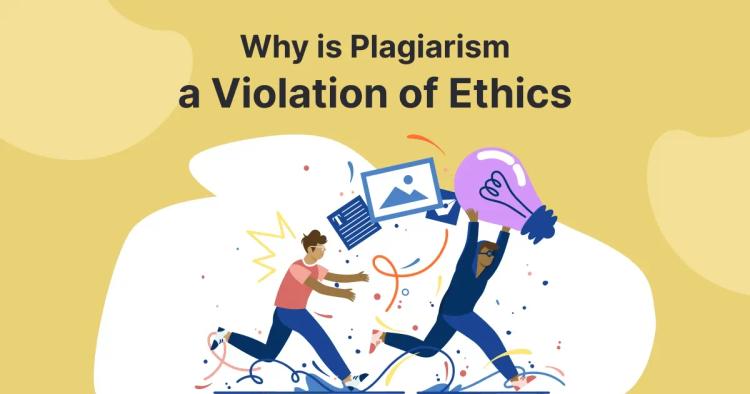Alright, imagine you're in a big playground where everyone is playing different games. Now, think of your school or workplace as a playground for learning and working. But there's this one not-so-cool thing that sometimes happens – it's called direct plagiarism.
Now, plagiarism is like playing a game, but instead of following the rules, some people try to take shortcuts. Direct plagiarism is like copying someone else's moves in the game without giving them credit. It's not fair, and it's not how we should play the game of learning and working together.
So, in this talk, we're going to explore what direct plagiarism is, why it's not a good idea, and how we can make our learning and working playground a fair and awesome place for everyone. Let's jump in and discover why direct plagiarism is the not-so-secret form of cheating!
ᴀᴅᴠᴇʀᴛɪsᴇᴍᴇɴᴛSignificance of Addressing Direct Plagiarism
Why bother about this plagiarism business? Well, it's not just about rules and regulations. It's about fairness, honesty, and respecting the effort someone puts into their work. When direct plagiarism occurs, it's not just the copied words that suffer but the essence of learning and creativity.
Understanding Direct Plagiarism
Examples of Direct Plagiarism
Direct plagiarism is like taking someone else's cake and putting your name on it. It's when people copy and paste, word for word, without saying, "Hey, this isn't mine!" For instance, imagine a student finding a cool essay online, copying it, and turning it in as if it were their own. That's direct plagiarism – using someone else's work without permission.
Another example is when a professional at work copies paragraphs from a colleague's report, thinking nobody will notice. But guess what? Copying without giving credit is like trying to sneak a snack in class – you'll get caught.
Consequences of Direct Plagiarism
Okay, let's talk about what happens when you get caught with your hand in the plagiarism cookie jar. In school, it can mean a big fat F on your assignment or even getting kicked out of class. At work, it's not just a slap on the wrist; it could cost you your job. Direct plagiarism is like playing with fire – you're bound to get burned.
The Not-So-Secret Nature of Direct Plagiarism
Common Instances in Academic and Professional Settings
Direct plagiarism isn't a rare bird; it's more like a common house pet. In school, students might copy each other's homework, thinking the teacher won't notice. But teachers have a sixth sense for this stuff – they can sniff out copied work from a mile away.
At work, professionals might copy parts of a presentation from the internet, hoping to impress their boss. Newsflash: bosses are pretty savvy too. They can tell when something doesn't add up. So, in both school and work, direct plagiarism is like trying to hide an elephant in a room – it's not going unnoticed.
The Ethical Implications
Let's talk about ethics. That's like asking, "Is it okay to take someone's lunch from the office fridge?" The answer is a big fat no. When you copy someone else's work without giving credit, it's not just breaking the rules; it's breaking trust. It's like saying, "I don't value your hard work; I'll just use it for my benefit." Ethical? Not at all.
So, when it comes to direct plagiarism, it's not just about getting caught. It's about understanding that everyone's effort deserves respect, just like how you'd want your lunch to be safe in the office fridge.
In a nutshell, direct plagiarism is like trying to be sneaky, but it rarely works out in your favor. It's a risky game that can cost you a lot of time in both school and work. Instead, why not embrace the challenge of creating something original? It's like baking your cake – much more satisfying, and no one can accuse you of stealing the recipe!
ᴀᴅᴠᴇʀᴛɪsᴇᴍᴇɴᴛPlagiarism Checker Tools: A Necessity
In a world filled with information, CopyChecker is the most accurate plagiarism checker that protects us from accidental plagiarism. This tool is designed to ensure our work is ours and not accidentally borrowed from someone else.
How Plagiarism Checkers Work
Imagine CopyChecker as detectives searching for clues in a vast library. It uses special algorithms to compare our work with tons of other online writings. If there's any similarity, it alerts us to double-check and make sure we're giving proper credit.
Importance of Using Plagiarism Checker Tool
Using CopyChecker isn't just a good idea; it's crucial. This tool helps us avoid unintentional mistakes and ensure that our hard work gets the credit it deserves. It’s like a safety net, preventing us from accidentally stepping into the territory of plagiarism.
Features of CopyChecker's Plagiarism Checker Tool
User-Friendly Interface
CopyChecker is designed to be easy for everyone. Its interface is like a friendly guide, making it simple for us to check our work without getting lost in complicated technical details.
Comprehensive Database
CopyChecker doesn't just skim the surface; it dives deep. It checks our work against a massive collection of information, making sure that even the smallest similarities are noticed.
Real-Time Analysis
In a world where time is precious, CopyChecker understands that. It provides results instantly, allowing us to see if there's any issue with our work right away. No waiting, just quick and helpful feedback.
Using CopyChecker isn't just about avoiding trouble; it's about ensuring that our work is authentic and truly ours. With these tools, we can navigate the sea of information with confidence, knowing that our originality is protected.
Benefits of Using CopyChecker
Academic Integrity Promotion
CopyChecker is like a superhero for your essays and reports. It doesn't just check for copied stuff; it promotes a culture where everyone plays fair. When you use Copychecker, you're not just protecting your work; you're making sure everyone gets credit for their original ideas.
ᴀᴅᴠᴇʀᴛɪsᴇᴍᴇɴᴛTime-Saving for Educators and Employers
Imagine your teacher having to read hundreds of papers. CopyChecker helps them save time, making sure they focus on your hard work instead of wasting time on copied stuff. For employers, it ensures they see the real you in job applications, not someone else's work.
Prevention of Unintentional Plagiarism
Sometimes, we don't mean to copy, but it happens. CopyChecker catches those accidental slips and helps you fix them. It's like having a helpful friend who watches your back, making sure you always give credit where it's due.
Addressing Direct Plagiarism: Educational Strategies
Raising Awareness
Let's start by talking to students and professionals about what direct plagiarism is and why it's a big deal. This means explaining that using someone else's work without giving credit is like taking credit for someone else's cooking recipe. It's just not fair. Schools and workplaces can organize workshops or put up posters to spread the word.
Teaching Proper Citation and Referencing
Imagine writing a song and someone else singing it without saying you wrote it. Not cool, right? Teaching proper citation and referencing is like making sure everyone knows who wrote the song. Schools can guide students on how to give credit when they use someone else's ideas. It's not about stopping them from using great ideas; it's about giving credit where it's due.
Fostering Originality
Think of it like this: if everyone wears the same outfit to a party, it gets boring. Schools and workplaces can encourage people to express their ideas and thoughts. This means creating an environment where being unique and original is celebrated. It's like having a party with everyone wearing different and exciting outfits.
Encouraging Academic and Professional Integrity
Integrity is a big word, but it means doing the right thing even when no one is watching.
Teaching integrity in schools means telling students that it's not just about following the rules; it's about doing the right thing because it's the right thing to do. It's like playing fair in a game. Imagine playing soccer, and someone keeps breaking the rules. It ruins the fun for everyone. That's why playing fair and doing the right thing is important.
In the professional world, integrity is like having a good reputation. Imagine going to a store where they sell you something that doesn't work. You wouldn't trust that store again. The same goes for professionals. Doing your work honestly and with integrity builds trust. It's like creating a good reputation that lasts.
So, whether you're a student or a professional, doing the right thing, being honest, and giving credit where it's due is like building blocks for success. It's not just about getting good grades or promotions; it's about creating a world where everyone can trust and respect each other.
FAQs
What is Direct Plagiarism?
Direct plagiarism is like taking someone else's painting and putting your name on it. It happens when you copy and paste someone's work without giving them credit.
Types of Plagiarism?
Plagiarism has a few sneaky forms. Apart from direct plagiarism, there's paraphrasing plagiarism (changing a few words but keeping the main idea), mosaic plagiarism (mixing your words with copied ones), and self-plagiarism (using your old work without permission).
Direct Plagiarism Example?
Imagine you write a cool story, and someone else decides to use the same words for their own story without saying you wrote it. That's direct plagiarism - like taking credit for someone else's creativity.
Cloning Plagiarism?
Cloning plagiarism is almost like making a photocopy of someone's work. It's when you duplicate a piece of writing, pretending it's yours. It's not just copying; it's like creating a clone of someone else's ideas without permission.
ᴀᴅᴠᴇʀᴛɪsᴇᴍᴇɴᴛConclusion
Direct plagiarism might seem like a shortcut, but in reality, it's dead-end. CopyChecker is not just a tool; it is a guardian of originality.
By understanding, addressing, and preventing direct plagiarism, we can build a world where success is earned through hard work, honesty, and the power of our ideas. So, let's embrace the journey of learning and creating, one original thought at a time.







